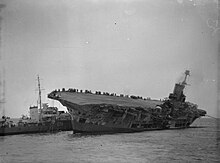HMS Ark Royal (91)
Designed in 1934 to fit the restrictions of the Washington Naval Treaty, Ark Royal was built by Cammell Laird at Birkenhead, England, and completed in November 1938.
Her sinking was the subject of several inquiries, with investigators keen to know how the carrier was lost in spite of efforts to save the ship and tow her to the naval base at Gibraltar.
[a] With a potential naval arms race developing between Britain, Japan and Italy, the British government sought a second treaty, which included limiting the maximum displacement of an aircraft carrier to 23,000 long tons (23,000 t).
[2] The deteriorating international situation by 1933, typified by Germany's rearmament and the expansion of Japan and Italy, convinced the British to announce funds for the carrier's construction in the 1934 budget proposals.
[17] Although intended for the Far East, events in Europe during the carrier's construction, including the Italian invasion of Abyssinia in 1935 and the Spanish Civil War in 1936, caused the Admiralty to mark her for deployment with the Home and Mediterranean Fleets.
[20] Ark Royal's armament was designed with anti-aircraft warfare in mind, as aircraft were expected to be the main threat; ships and submarines could be outrun or dealt with by escorts.
[27] On 14 September, Ark Royal received a distress call from SS Fanad Head, which was 200 nautical miles (230 mi; 370 km) away under pursuit from the surfaced U-30.
[33] To prove the German propaganda false before it had a negative effect on Britain's allies, Winston Churchill reassured United States President Franklin Delano Roosevelt that the carrier was undamaged and invited the US naval attaché to view Ark Royal in dock.
[34] In October 1939, Ark Royal was redeployed to Freetown to operate off the African coast in the hunt for the German commerce raider Admiral Graf Spee.
[39] With Graf Spee sunk, Ark Royal remained in the Atlantic for a short time before escorting the damaged heavy cruiser Exeter back to Devonport Dockyard, where they arrived in February.
[40] Ark Royal was then assigned to the Mediterranean Fleet for exercises, departing Scapa Flow on 31 March 1940 and heading for Alexandria with the aircraft carrier Glorious.
[40] Ark Royal and Glorious arrived at Scapa Flow on 23 April 1940 and were immediately redeployed as part of Operation DX, sailing to Norway with the cruisers Curlew and Berwick and screened by the destroyers Hyperion, Hereward, Hasty, Fearless, Fury and Juno.
[11][24] Ark Royal returned to Scapa Flow on 27 April to refuel and replace lost and damaged aircraft, before heading back on the same day with the battleship Valiant as escort.
[56] En route, diversionary attacks were planned on Italian air bases at Elmas and Cagliari to direct attention from both the reinforcement operation and a supply convoy sailing to Malta.
[61] The Italian fleet was detected by a reconnaissance aircraft from Ark Royal and the carrier launched Swordfish torpedo bombers while the capital ships of Force H turned to meet the enemy.
[68] In early February 1941, the battleships Scharnhorst and Gneisenau headed into the Atlantic during Operation Berlin on the orders of Grand Admiral Erich Raeder, commander of the German Navy.
[73] Ark Royal spent April alternating between covering convoys and delivering aircraft to Malta and forays into the Atlantic to hunt commerce raiders.
Over the day, 12 of Ark Royal's Fairey Fulmars (the maximum number available) drove off over 50 aircraft, with the assistance of targeting information from Sheffield's radar and anti-aircraft fire from the escorts.
After sinking the battlecruiser Hood and damaging the battleship Prince of Wales during the Battle of the Denmark Strait, Bismarck shook off her pursuers and headed for the French Atlantic coast.
[84] At the time of detection, the British ships were 130 nmi (240 km; 150 mi) away and would not catch Bismarck before she reached Saint-Nazaire, putting her safely under the air cover of the Luftwaffe once in range and while being repaired at the Normandie drydock.
Three torpedoes hit the battleship: two detonated forward of the engine rooms, while the third struck the starboard steering compartment and jammed her rudder in a 15° port turn.
Malta remained an important stronghold in the Mediterranean, but was coming under increased pressure from Italian and German air attacks, and could no longer be supplied from the east since the Battle of Crete.
[92] The continued Allied presence in Malta was a considerable problem for Rommel in Africa, who was losing as much as ⅓ of his supplies from Italy to submarines and bombers based there.
[96] The explosion caused Ark Royal to shake, hurled loaded torpedo-bombers into the air, and killed 44 year old Able Seaman Edward Mitchell, the only man to die in the sinking.
[99] The ship's continued motion enlarged the hole in the hull, and by the time Ark Royal stopped she had taken on a great deal of water and begun to list to starboard, reaching 18° from centre within 20 minutes.
[99] Considering the list of Ark Royal, and the fact that other carriers, including Courageous and Glorious, had sunk rapidly with heavy loss of life, Maund gave the order to abandon ship.
Admiral Somerville, determined to save Ark Royal, ordered damage control parties back to the carrier before taking the battleship Malaya to Gibraltar to organise salvage efforts.
The destroyer Laforey came alongside to provide power and additional pumps, while Swordfish aircraft from Gibraltar flew overhead to supplement anti-submarine patrols.
[109][110] The Board of Inquiry closed its report with the observation that Ark Royal had sunk 22 nautical miles (25 mi; 41 km) east of Europa Point, the southernmost tip of Gibraltar.
A large debris field, which includes the funnel and bridge island, parts of the ship that came loose as the carrier sank, and aircraft from the hangars, lies between the two hull sections.












